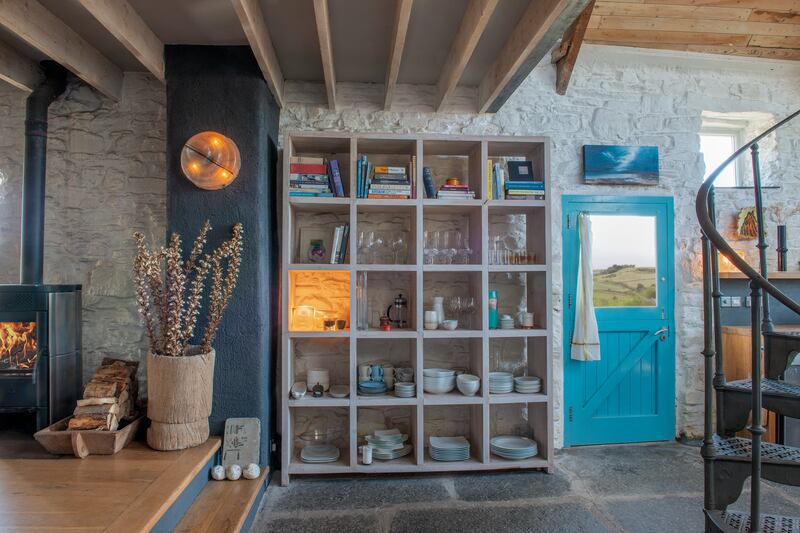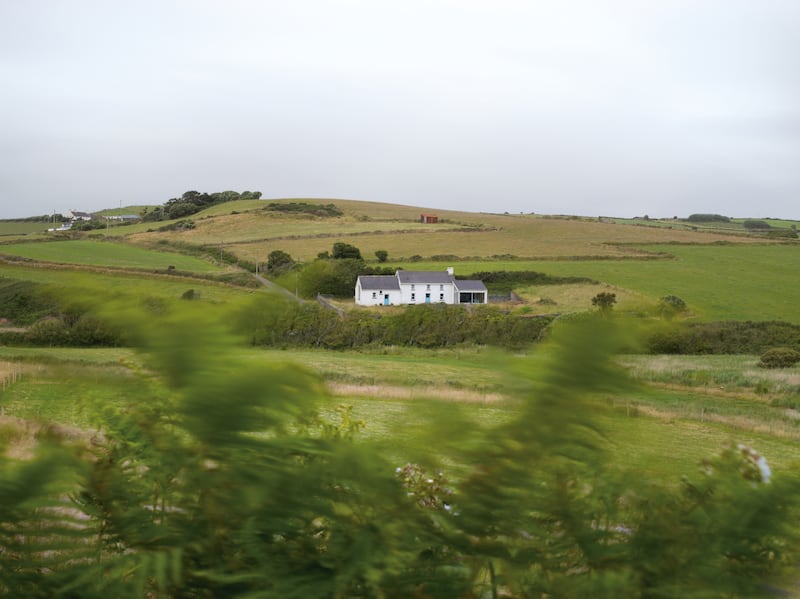Judging by the popularity of shows like Grand Designs, Room to Improve and even Escape to the Chateau, we are all a little obsessed by the idea of transforming our homes into the stuff of dreams. Be it a bijoux apartment in the city, a grand country pile, a rustic gîte or a cute cottage by the sea, it’s a goal for many of us.
So it’s not surprising then that David Magee, an Irish photographer who resides between Cork and London, was bewitched by an old farmhouse in west Cork, which he purchased “for a song” over two decades ago.
“The house was the last remaining asset of what had been quite an extensive farm, which the owner had decided to sell off and relocate,” he says. “After much wrangling and negotiation, we settled on a price of 140,000 punts (€177,800, he bought it in September 2000) for the farmhouse and the remaining two acres of land. I couldn’t have been more delighted as it seemed perfect. So I immediately set about making plans for turning the neglected house into a home”.
The house, which is located about 32km (20 miles) southwest of Cork Harbour and in the eastern part of Clonakilty Bay, is situated west of the Seven Heads, near Dunworley Beach, which, Magee says is a “magnificent picturesque peninsula of rugged cliffs and shoreline that divides Clonakilty and Courtmacsherry Bays”.
READ MORE
The building had no foundations to speak of and was not simply damp, but very much reeking of moisture
“It was in the style of the traditional Irish farmhouse with one room to the left and another to the right of the main door. There was a central staircase, two bedrooms upstairs and a chimney at each end of the house and the unused structures, adjacent to the house were historically used to shelter livestock house coal, peat and logs.
“But it was in need of substantial repair and many people advised me to ‘knock and start again’. However, I was determined to retain the integrity of the building and reinstate it to its former glory.”
[ Bohemian blow-ins: Crafting an arts movement in west CorkOpens in new window ]
This, however, would prove more difficult than it seemed, and the father-of-four soon realised that his project would require more work than he had initially thought.
“It quickly became apparent that I had purchased little more than a site,” he says. “The building had no foundations to speak of and was not simply damp, but very much reeking of moisture. No surrounding drainage existed and the pointing of the rough stone, which made up the vast majority of the house, was in a terrible state. In fact nothing could really remain as it was — so everything needed to be done.


“With the exception of creating an entirely new roof (straight away), it was a case of drawing up a list and prioritising. My initial emphasis was on the ground works — and establishing a drainage system to keep water away from the house. We then focused on ripping everything out, which meant all existing wiring, and plumbing along with hacking out and repairing all the pointing with lime mortar.
“I decided to use lime based products (Natural Hydraulic Lime) for all pointing stonework and plastering throughout. Hydraulic lime was also used to paint the exterior upon completion, which in turn, because of the natural chalky finish of the exterior — created the name ‘The White House’. I employed individual specialist local tradesmen to work with me throughout and where I was capable of completing the works myself, I did — including the laying of the Liscannor Floors in the kitchen and utility areas.”
Magee, who was born and raised in Cork, lives with his partner Sharon and their two dogs and says he began working on his dream home in early 2001 — but it took many years before the project was completed.
I travelled extensively, mainly to Asia, throughout that period and was excited about the opportunity to integrate interior ideas I had seen and noted on my travels
“We started the first phase in the spring of 2001 and this lasted around nine months,” he says. “This period saw the transformation of all the living quarters to second fix stage. It involved putting in damp course throughout and the taking apart and the reinstallation of large sections of the main front wall of the house which over the years had bowed substantially. The main gable end, which led into the stable, was opened up and a mezzanine to the upstairs bedroom was established. The only structural block work addition was at the rear of the house and this involved the addition of a utility and shower room. Then the following spring saw the completion of all interior decorating.
“But the second stage, which we called the transformation of the “west wing” from storage shed to glass fronted study — happened a number of years afterwards when I had time to live in the house and get a feel for it.”
Having spent much of his childhood holidays in the region, Magee drew inspiration for the interior design of the house, both from the immediate environs surrounding the site and also from countries he had travelled to over the years.
“My childhood was made up of weekend fishing trips with my family to this area from Cork City where we lived — and I was determined from an early age to make it (the locality) my home,” he says. “And as with the initial vision for the refurbishment of the house, when it came to interior design, it was the blank canvas I had always hoped for. I travelled extensively, mainly to Asia, throughout that period and was excited about the opportunity to integrate interior ideas I had seen and noted on my travels.
For me it’s not just the house that’s important — it is also the location by the sea. This ancient and spectacular coastline of West Cork is where my heart lives
“I wanted to use (local) natural materials and a carefully curated mix of vintage and modern pieces throughout to create an individual home, which represented me and my character. I also wanted to create a space to live and work in: where a combination of old and new, textures, layers, colours, personal touches and art works could all work together.”
As it is a second home, the budding builder was able to take his time with the build and managed not to overspend, but he says there are still some areas in which he would do things differently if he had his time again.
“Throughout the various stages, the budget was pretty well stuck to,” he says. “I think principally because I was realistic about costs from the outset and factored in enough of a financial cushion for additions and amendments.


“The only regret or hiccup was with the natural oak flooring. I had a vision for lovely wide board kiln-dried character flooring throughout most of the living areas. However, I also wanted underground heating everywhere. In retrospect I didn’t have enough experience with this at the time and it simply didn’t ever work efficiently. Hindsight is a wonderful thing — and I would certainly approach that today in a different fashion.”
Although the artist has another property in London — his work will next be on show at the StART Art Fair at the Saatchi Gallery in the city later this month — the house in Cork is where his heart is and where he spends the most time. Now, more than 20 years after deciding to buy the old house and surrounding land, he is still just as enamoured with it as he was when he first came across many decades ago.
“Today the house is very much my home and although I also live in the UK and travel a lot throughout the year, it is where my heart is and where I feel most aligned,” he says. “I would say that I probably spend about a third of the year there.
“Overall, I am thrilled with the final result. Of course, looking back, there are things I could and maybe would have done differently — but there is always more than one solution to most problems. The White House (and the memories of its reincarnation) remains one of my proudest achievements in life — after my children of course.
“But for me it’s not just the house that’s important — it is also the location by the sea. This ancient and spectacular coastline of West Cork is where my heart lives.”
Biggest mistake?
“The knocking down of a free-standing cottage, which lay adjacent to the farmhouse. Even though I had been approved for planning permission to reconvert it as a stand alone dwelling — at the time of renovation of the farmhouse, I felt I simply didn’t need it. In retrospect, this was a mistake.”
Biggest win?
“My favourite thing is quite simply how well the “west wing” worked out. It converted, what was in essence, a dead space into a studio or study space where I now spend most of my time. It’s an individual work space, both functional and comfortable, which makes me feel very much ‘in the landscape’.”




















